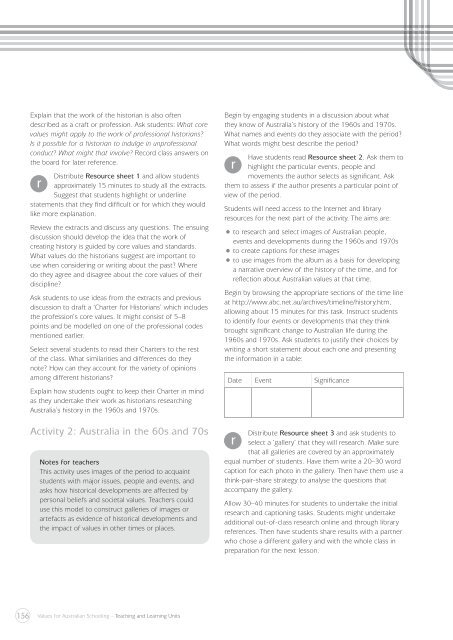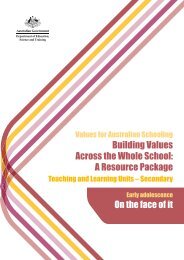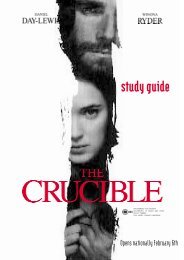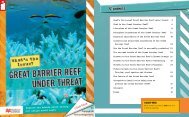Changing values, changing nation - Saint Ignatius' Moodle Community
Changing values, changing nation - Saint Ignatius' Moodle Community
Changing values, changing nation - Saint Ignatius' Moodle Community
Create successful ePaper yourself
Turn your PDF publications into a flip-book with our unique Google optimized e-Paper software.
Explain that the work of the historian is also often<br />
described as a craft or profession. Ask students: What core<br />
<strong>values</strong> might apply to the work of professional historians?<br />
Is it possible for a historian to indulge in unprofessional<br />
conduct? What might that involve? Record class answers on<br />
the board for later reference.<br />
Distribute Resource sheet 1 and allow students<br />
approximately 15 minutes to study all the extracts.<br />
Suggest that students highlight or underline<br />
statements that they find difficult or for which they would<br />
like more expla<strong>nation</strong>.<br />
Review the extracts and discuss any questions. The ensuing<br />
discussion should develop the idea that the work of<br />
creating history is guided by core <strong>values</strong> and standards.<br />
What <strong>values</strong> do the historians suggest are important to<br />
use when considering or writing about the past? Where<br />
do they agree and disagree about the core <strong>values</strong> of their<br />
discipline?<br />
Ask students to use ideas from the extracts and previous<br />
discussion to draft a ‘Charter for Historians’ which includes<br />
the profession’s core <strong>values</strong>. It might consist of 5–8<br />
points and be modelled on one of the professional codes<br />
mentioned earlier.<br />
Select several students to read their Charters to the rest<br />
of the class. What similarities and differences do they<br />
note? How can they account for the variety of opinions<br />
among different historians?<br />
Explain how students ought to keep their Charter in mind<br />
as they undertake their work as historians researching<br />
Australia’s history in the 1960s and 1970s.<br />
Activity 2: Australia in the 60s and 70s<br />
Notes for teachers<br />
This activity uses images of the period to acquaint<br />
students with major issues, people and events, and<br />
asks how historical developments are affected by<br />
personal beliefs and societal <strong>values</strong>. Teachers could<br />
use this model to construct galleries of images or<br />
artefacts as evidence of historical developments and<br />
the impact of <strong>values</strong> in other times or places.<br />
Begin by engaging students in a discussion about what<br />
they know of Australia’s history of the 1960s and 1970s.<br />
What names and events do they associate with the period?<br />
What words might best describe the period?<br />
Have students read Resource sheet 2. Ask them to<br />
highlight the particular events, people and<br />
movements the author selects as significant. Ask<br />
them to assess if the author presents a particular point of<br />
view of the period.<br />
Students will need access to the Internet and library<br />
resources for the next part of the activity. The aims are:<br />
• to research and select images of Australian people,<br />
events and developments during the 1960s and 1970s<br />
to create captions for these images<br />
• to use images from the album as a basis for developing<br />
a narrative overview of the history of the time, and for<br />
reflection about Australian <strong>values</strong> at that time.<br />
Begin by browsing the appropriate sections of the time line<br />
at http://www.abc.net.au/archives/timeline/history.htm,<br />
allowing about 15 minutes for this task. Instruct students<br />
to identify four events or developments that they think<br />
brought significant change to Australian life during the<br />
1960s and 1970s. Ask students to justify their choices by<br />
writing a short statement about each one and presenting<br />
the information in a table:<br />
Date Event Significance<br />
Distribute Resource sheet 3 and ask students to<br />
select a ‘gallery’ that they will research. Make sure<br />
that all galleries are covered by an approximately<br />
equal number of students. Have them write a 20–30 word<br />
caption for each photo in the gallery. Then have them use a<br />
think-pair-share strategy to analyse the questions that<br />
accompany the gallery.<br />
Allow 30–40 minutes for students to undertake the initial<br />
research and captioning tasks. Students might undertake<br />
additional out-of-class research online and through library<br />
references. Then have students share results with a partner<br />
who chose a different gallery and with the whole class in<br />
preparation for the next lesson.<br />
156 Values for Australian Schooling – Teaching and Learning Units







